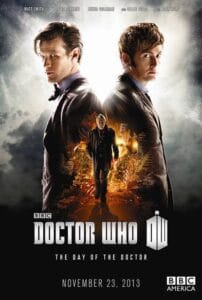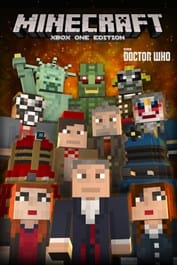This post is the conclusion of a series of posts investigating Henry Jenkins’ concepts of “Convergence Culture” and “Transmedia Storytelling”.
See the full series here.

The Star Beast (Talalay, 2023), Wild Blue Yonder (Kingsley, 2023) and The Giggle (Button, 2023) averaged 4.84 million viewers overnight (TV Zone, 2024), though Jim Waterson highlights from the Ofcom report that “TV broadcast in a given week has declined from 83% in 2021 to 79% in 2022 . . . [the figure] even lower among 16- to 24-year-olds, with just 54% of young people watching any live television” (2023, para. 3), so it is difficult to compare 2013 to 2023, especially considering the post-COVID streaming boom (Lai, 2021).

Successful transmedia storylines were created through that of Time Lord Victorious and the earlier examples of The Sarah Jane Adventures (Davies et. al., 2007-2011) and Torchwood. The BBC have explored newer areas, such as the A Dalek Awakens escape room experience, or Daleks! YouTube animated series (Doctor Who, 2020) “[allowing] passive audiences to simply sit back and enjoy the parent show in blissful isolation, while at the same time [giving] active, migratory and participatory audiences opportunities to engage in a rich, and extended multimedia experience” (Perryman, 2008, p. 37).
The BBC has demonstrated a willingness to produce forms of media other than the traditional television series and novels and must do so to keep Doctor Who relevant. However, transmedia storytelling is not the first and only step to generate revenue, rather the other media these texts can encourage audiences towards.
Matt Hills writes that Torchwood operated “within the BBC’s institutional agendas and aims . . . channelling Torchwood’s fans towards Radio 4 . . . thereby boosting the younger audience and the demographic reach for the BBC’s upscale radio station” (2012, p. 414). This indicates the BBC planned to use Torchwood as a tool to raise audience figures with their pre-existing products and services.
Hills notes that the “use of transmedia material cannot be readily monetised by the BBC” as it would question their stance as a public service broadcaster (p. 414). This is supported by the Time Lord Victorious story, with each text directing an audience towards a different service, for example, after purchasing an audiobook on Audible, the platform may recommend more BBC-produced audiobooks for you to purchase.

Russell T. Davies has expressed his desire to transform Doctor Who by “[shifting it] up a gear” (Davies, 2021, as quoted in Chilton, 2021, para. 5), and by giving it the same attention Disney gave to the Marvel Cinematic Universe and Star Wars Universe.
With the production capabilities of Disney, it is certainly possible the “Whoniverse” will evolve into something resembling the structure of these franchises. These creative teams can work closely together to ensure a close continuity and avoid past examples of lack of communication between authors allowing them to surpass their previous achievements of producing “[their] most successful attempt at turning a transmedia strategy into a successful and sustainable reality” (Thompson, 2007, as quoted in Perryman, 2008, p. 22).
- Button, C. (Director). (2023, December 9). The Giggle [TV special]. BBC Wales; Bad Wolf.
- Chilton, L. (2021, January 23). Doctor Who: Russell T Davies says a Marvel-style shared universe ‘will happen one day’. Independent. https://www.independent.co.uk/arts-entertainment/tv/news/doctor-who-russell-t-davies-mcu-b1791627.html
- Davies, R. T., Wilson, N., Gardner, J., Wenger, P., & Collinson, P. (Executive Producers). (2007-2011). The Sarah Jane Adventures [TV series]. BBC Wales.
- Doctor Who. (2020, November 12). 01: The Archive of Islos | DALEKS! | Doctor Who. [Video]. YouTube. https://www.youtube.com/watch?v=d-HJqrE0fbk
- [Doctor Who Disney+]. (n.d.). Retrieved 28 January 2025, from https://images.app.goo.gl/dYBbYL745Bw8vn618
- [Doctor Who x Minecraft]. (n.d.). Retrieved 28 January 2025, from https://www.xbox.com/en-GB/games/store/minecraft-doctor-who-skins-volume-i/BSN60R8KM585
- Garfield, R. (1993). Magic: The Gathering [Trading card game]. Wizards of the Coast.
- Guardian, The. (2013, November 24). Doctor Who 50th anniversary episode beaten by Strictly in ratings. The Guardian. https://www.theguardian.com/tv-and-radio/2013/nov/24/doctor-who-50th-anniversary-episode-ratings
- Hills, M. (2012). Torchwood’s trans-transmedia: Media tie-ins and brand ‘fanagement’. Participations 9(2). 409-428.
- Hurran, N. (Director). (2013, November 23). The Day of the Doctor [TV film]. BBC Worldwide.
- Kingsley, T. (Director). (2023, December 2). Wild Blue Yonder [TV special]. BBC Wales; Bad Wolf.
- Lai, A. (2021, June 21). Post-Pandemic Media Consumption: Online Streaming Accelerates A New Content Experience. Forrester. https://www.forrester.com/blogs/post-pandemic-media-consumption-online-streaming-accelerates-a-new-content-experience/?utm_source=forbes&utm_medium=pr&utm_campaign=b2cm
- Perryman, N. (2008). Doctor Who and the Convergence of Media. The International Journal of Research into New Media Technologies 14(1), 21-39.
- Talalay, R. (Director). (2023, November 25). The Star Beast [TV special]. BBC Wales; Bad Wolf.
- [The Day of the Doctor (Hurran, 2013) poster]. (n.d.). Retrieved 28 January 2025, from https://www.imdb.com/title/tt2779318/mediaviewer/rm3226590720
- TV Zone. (2024, February 2). DOCTOR WHO: 28-DAY CONSOLIDATED RATINGS FOR 60th ANNIVERSARY SPECIALS REVEALED. TV Zone. https://www.tvzoneuk.com/post/drwho-60thspecials-28days
APA7
Cable, J. (2025, Apr 23). Doctor Who, Media Convergence & Transmedia Storytelling – Conclusion. JCableMedia.com. [permalink].
Chicago
Cable, John. “Doctor Who, Media Convergence & Transmedia Storytelling – Conclusion.” JCableMedia.com. April 23, 2025. [permalink].
Harvard
Cable, J. (2025). Doctor Who, Media Convergence & Transmedia Storytelling – Conclusion. Available at: [permalink] (Accessed: 30 November 2025).